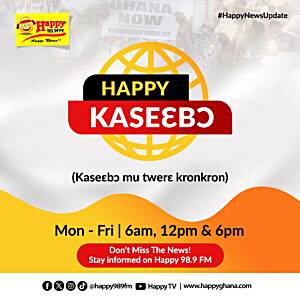Throughout his life Prince Philip was a constant presence by the Queen’s side. Just as Queen Elizabeth II is the longest-reigning British monarch, Philip held the record as the longest-serving consort. The couple was married for more than 70 years, and theirs was a love match right from the start. “She never looked at anyone else,” the Queen’s cousin Margaret Rhodes wrote in her memoir, The Final Curtsey.
READ MORE: Obituary: HRH The Prince Philip, Duke of Edinburgh
Their first proper encounter was in 1939, when the young naval cadet Prince Philip of Greece and Denmark was asked to entertain 13-year-old Princess Elizabeth and her sister, Princess Margaret, while their parents toured Britannia Royal Naval College, in Dartmouth, southwestern England. During World War II, Elizabeth and Philip began regular correspondence, and a romance blossomed. However, it wasn’t until after Elizabeth turned 21 that Buckingham Palace announced their engagement, in July 1947. They were married a few months later, in November, and Philip was given the title Duke of Edinburgh.
“I think the main lesson that we have learnt is that tolerance is the one essential ingredient of any happy marriage…. You can take it from me that the queen has the quality of tolerance in abundance.
Philip gave up his promising military career to support his wife, and he told the BBC many years later that “nobody had much idea” of what his work should be. “There was no precedent. If I asked somebody, ‘What do you expect me to do?’ they all looked blank. They had no idea,” he told the broadcaster in an interview to mark his 90th birthday, in 2011.
Nevertheless, he threw himself into his role, eventually becoming patron or president of more than 780 organizations. Once describing himself as “the world’s most experienced plaque- unveiler,” Prince Philip carried out 22,191 engagements and gave 5,493 speeches before his retirement, in August 2017. He became concerned about the environment long before those views were fashionable, and he also showed a keen interest in sports and industry. Perhaps his most notable endeavor is his eponymous initiative, The Duke of Edinburgh’s Award, founded in 1956, which has engaged millions of young people around the world in 144 nations. Participants compete for bronze, silver, and gold awards by completing various challenges in volunteering, skills, physical recreation, and expedition.
Philip was known for having a no-nonsense attitude, both in public and behind closed doors. During official visits over the years, he made many blunt, sometimes witty, and occasionally offensive remarks that were famously referred to as his gaffes. Following his retirement, he was rarely seen in public. However, he remained the Queen’s steadfast companion behind the scenes. Their relationship was perhaps best summed up by Lord Charteris, the Queen’s former private secretary, who told author Gyles Brandreth, “Prince Philip is the only man in the world who treats the Queen simply as another human being. He’s the only man who can. Strange as it may seem, I believe she values that.”
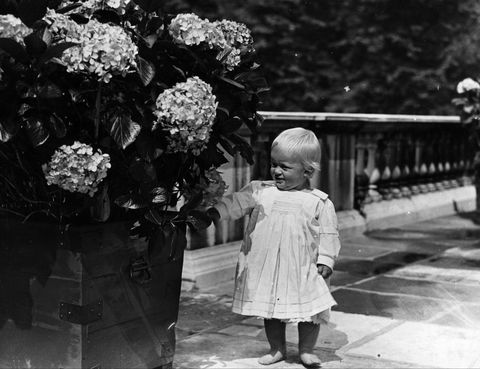
JULY 1922 Prince Philip at age one. He was born Prince Philip of Greece and Denmark on June 10, 1921, on the Greek island of Corfu. He is the only son of Prince Andrew of Greece and Denmark and Princess Alice of Battenberg and had four older sisters. In September 1922, as defeat loomed in the Greco-Turkish War, a military revolt forced Philip’s uncle King Constantine I of Greece to abdicate his throne. Philip’s family fled to France, with baby Philip transported in a wooden fruit box. They settled in Paris. There, Philip attended English-speaking school The Elma. By 1930 he was living in England with his maternal relatives, the Mountbattens, and attending Cheam School in Cheam, Surrey.

JULY 1935Prince Philip, at age 14, dresses for GordonstounSchool’s production of Macbeth. In 1933, hebriefly attended Schule Schloss Salem boardingschool in south Germany before transferringto Gordonstoun School in Scotland. Germaneducator Kurt Hahn established both schools, andhis teachings had a big influence on Philip. Philip’smother was diagnosed with schizophrenia in 1930and placed in a sanatorium, and it is understoodthat he had little contact with her for much of hischildhood. When asked by the BBC in an interviewfor his 90th birthday whether his childhood wasunsettling, Philip bluntly replied, “Well, I just livedmy life—I haven’t been trying to psychoanalyzemyself all the time.”FOX PHOTOSGETTY IMAGES

JULY 1939 A 13-year-old Princess Elizabeth (seated, thirdfrom left) focuses her attention ahead, while 18-year-old naval cadet Prince Philip (standing, far right) converses behind her at the Britannia Royal Naval College, in Dartmouth. Prince Philip had been charged with entertaining the young princesses, Elizabeth and Margaret. This was Philip and Elizabeth’s first substantive encounter,although they are third cousins through their mutual ancestry to Queen Victoria and both attendedthe same wedding in 1934. Elizabeth’s governess Marion Crawford wrote about their time together in Dartmouth in her book, The Little Princesses: “At the tennis courts, I thought he showed off a good deal, but the little girls were much impressed. Lilibet said, ‘How good he is, Crawfie. How high he can jump.’ She never took her eyes off himthe whole time.” The following day, Philip joined the royal family for lunch, and Crawford recalled how Elizabeth “sat, pink-faced, enjoying it all very much.”

OCTOBER 26, 1946 Princess Elizabeth walks with her family and Philip (far right) at the wedding of Lady Patricia Mountbatten to Lord Brabourne at Romsey Abbey, in Hampshire. Elizabeth and Philip had been in contact during the war years. Philip visited Windsor Castle, where the royal sisters stayed during the war, and watched them perform in a pantomime. Following the war, he began to visit Elizabeth regularly at Buckingham Palace. Governess Marion Crawford noted in her book that Philip loved Elizabeth “very much” and that he was “a forthright and completely natural young man.” By October 1946, there was much public speculation about their relationship. Photographs of Elizabeth and Philip chatting together before Lady Mountbatten’s wedding as they entered the abbey for the service fueled the gossip. Philip was seen helping Elizabeth and Margaret with their coats, which further spurred speculation about them.PA IMAGESGETTY IMAGES

JULY 10, 1947 Princess Elizabeth and Prince Philip sit for an official photograph the day after the announcement of their engagement, on July 9, 1947. It is widely believed that they secretly became engaged in 1946. However, King George VI is understood to have asked that the couple wait until after Elizabeth was 21 to formalize the engagement. During that waiting period, Philip renounced his Greek and Danish titles, became a naturalized British citizen, and took the surname of his uncle Louis, 1st Earl Mountbatten of Burma. Mountbatten was also a distant cousin to Elizabeth and was a statesman and British Royal Navy officer. The official engagement announcement from the palace said that “the King has gladly given his consent” to the union.

NOVEMBER 19, 1947 Prince Philip enjoys himself with friends at his stag party. He had two stag parties: one the night before the wedding at the Dorchester Hotel in London that the media was invited to photograph (shown here) and the other a private party on November 14 with his closest friends at the Belfry Club in London. Philip and many of his friends were members of the Thursday Club, which met weekly for lunch at a restaurant in London’s Soho. His best man was the aristocrat David Mountbatten, 3rd Marquess of Milford Haven, who served in the Royal Navy. Other friends included society photographer Baron Nahum and expressionist painter Feliks Topolski.EXPRESSGETTY IMAGES

NOVEMBER 20, 1947 Princess Elizabeth and Prince Philip pose for photographs on their wedding day. They were married at 101:30 a.m. before 2,000 guests at Westminster Abbey. An estimated 200 million people tuned into the BBC radio broadcast of the event. Elizabeth had eight bridesmaids, including her sister, Princess Margaret. On the morning of the wedding, Philip asked his cousin Patricia Mountbatten, “Am I being very brave or very foolish?” Upon the marriage, he was given the primary title of Duke of Edinburgh along with the titles Earl of Merioneth and Baron Greenwich, of Greenwich in the county of London. It was not until 10 years later, in 1957, that Philip was officially made a prince of the United Kingdom, when the Queen issued a special document, known as a letters patent, to that effect.

NOVEMBER 20, 1947 Princess Elizabeth arrives at Westminster Abbey with her father on her wedding day. They traveled in the Irish State Coach to the service, which was officiated by Geoffrey Fisher, the Archbishop of Canterbury. King George VI wrote to his daughter afterward, “When I handed your hand to the Archbishop, I felt I had lost something very precious. You were so calm and composed during the service and said your words with such conviction that I knew everything was all right.” After the service, a reception was held at Buckingham Palace. The couple received more than 2,500 presents and 10,000 telegrams of congratulations. According to details released by the royal household, gifts included a bookcase from Queen Mary and a picnic case from Princess Margaret. The presents were put on display at St. James’s Palace, where the public could view them.POPPERFOTO

NOVEMBER 1947 The newlyweds look at their wedding photos on their honeymoon. The couple spent their wedding night and the first part of their honeymoon at Broadlands, in Hampshire, the home of Louis, 1st Earl Mountbatten of Burma, Philip’s uncle. From there, they traveled to Birkhall, on the Balmoral Estate, in Scotland, for the rest of their honeymoon. In a letter to her parents while on her honeymoon, Elizabeth wrote how she and Philip “behave as though we had belonged to each other for years.” He also wrote to his mother-in-law not long after they were wed, declaring, “Cherish Lilibet? I wonder if that word is enough to express what is in me.”

NOVEMBER 1948 Well-wishers outside Buckingham Palace wait for the official announcement of the birth of Prince Charles. Almost exactly a year after they married, Elizabeth and Philip welcomed their first child. Charles was born at Buckingham Palace on November 14, 1948. Like many fathers of that era, Philip was not present for the birth and is instead believed to have been playing squash with his private secretary Mike Parker. As a boy, Charles was born heir apparent. At this time, the family lived in Clarence House, in London, and would move into Buckingham Palace when Elizabeth became queen.FOX PHOTOSGETTY IMAGES
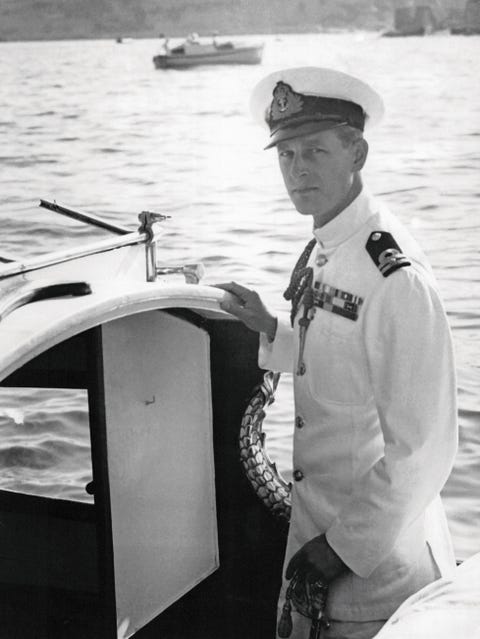
OCTOBER 20, 1949 Prince Philip poses in his naval uniform. After attending Gordonstoun, Philip began training with the Royal Navy. He graduated from Britannia Royal Naval College and served in the British forces during World War II. Philip was mentioned in dispatches after manning searchlights during the Battle of Cape Matapan in 1941. He later wrote about the incident in the foreword of a book called Dark Seas, published in 2012: “I reported that I had a target in sight and was ordered to ‘open shutter.’” Philip went on to describe how “hell broke loose” as the guns began firing at the cruiser, which “disappeared in an explosion and a cloud of smoke.”
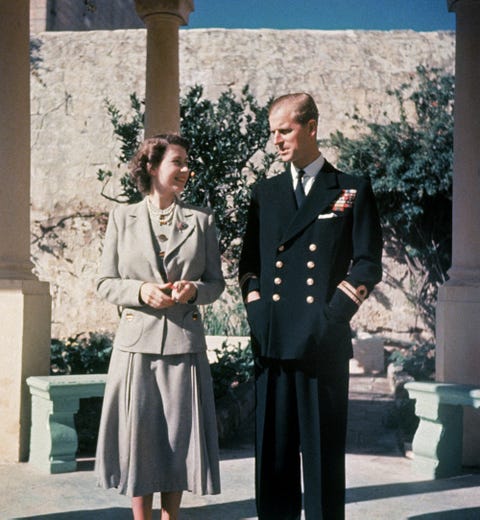
NOVEMBER 1949 Princess Elizabeth and Prince Philip in Malta. The couple resided on the island on and off between 1949 and 1951 when Philip was posted there with the Royal Navy. They resided in the Villa Guardamangia and attended dances with other military families. This was a rare period when Elizabeth was able to live like a normal naval wife. Philip was a first lieutenant when he was initially posted to Malta; in 1950, he was promoted to lieutenant commander and then placed in charge of HMS Magpie. He left active service prematurely and abruptly in July 1951 as the health of King George VI started to deteriorate rapidly. Elizabeth had already begun to take on more of her father’s royal duties, most notably standing in to take the salute in Trooping the Colour, an annual event to mark the official birthday of the British sovereign, in June 1951. In September 1951, the King had an operation to remove part of his lung.HULTON ARCHIVE

FEBRUARY 3, 1952 Princess Elizabeth and Prince Philip attend a polo match in Nyeri, Kenya, during an official visit to the country. It turned out to be just days before her father died after suffering from lung cancer. Elizabeth left for Kenya as a princess and returned to the United Kingdom as its queen. In her memoir Daughter of Empire, Pamela Mountbatten, Elizabeth’s lady-in-waiting, recalled how it was Philip who broke the news of King George VI’s death to Elizabeth, in the garden of a Kenyan lodge. She wrote how Elizabeth “remained completely calm and said simply, ‘I am so sorry. This means we all have to go home.’

JUNE 2, 1953 Prince Philip kneels before his wife at her coronation. During the ceremony, he wore a coronet and robe over his naval uniform. The service saw him pay homage to his wife and promise to be her “liege man of life and limb.” As chair of the Coronation Commission, Philip was also involved in organizing the event.FOX PHOTOSGETTY IMAGES

Date Unknown Prince Philip walks behind his wife as they arrive in Suva, Fiji. The Queen has visited Fiki several times, including during her six-month Commonwealth tour shortly after she was crowned. Between November 1953 and May 1954, the couple traveled more than 40,000 miles by land, sea, and air touring 13 Commonwealth countries. In an era when most people did not have access to television, these personal visits were even more important to establish a bond between the royal family and the people. In public, Philip has often walked a few steps behind his wife; however, it has often been said that things were rather different in private. “Elizabeth wore the crown, but Philip wore the trousers,” author Gyles Brandreth wrote in Philip & Elizabeth: Portrait of a Marriage.

1950s The Queen and Prince Philip play with their children Prince Charles and Princess Anne at Balmoral Castle, in Scotland. The couple welcomed their second child, Anne, into the world on August 15, 1950. She was born third in line to the throne, but as the order of succession then favored male heirs, Anne was later overtaken in the line of succession by her younger brothers, Andrew and Edward. Philip’s children did not take his surname, Mountbatten, and instead were given the surname Windsor, which King George V had adopted. However, in 1960, it was declared in the Privy Council that direct descendants without royal styles and titles would use the name Mountbatten-Windsor. This is the surname the Duke and Duchess of Sussex, Prince Harry and Meghan, gave their son, Archie, in 2019.PA IMAGESGETTY IMAGES
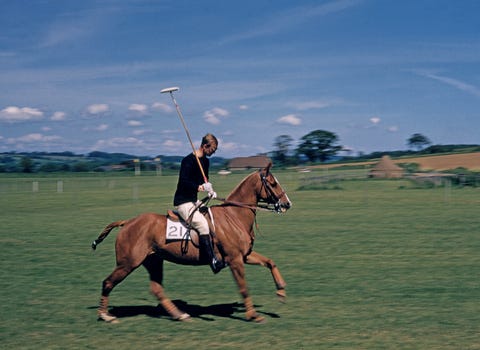
1955 Prince Philip enjoys his recreational time. In his youth, Philip was a keen polo player. He took part in the sport for some 20 years before retiring in 1971, when he took up carriage riding. He championed the activity and continued to ride well into his 90s. He also enjoyed flying and gained his Royal Air Force wings in 1953, his helicopter wings in 1956, and his private pilot’s license in 1959. In addition, Philip has written extensively on the environment and technology and is the author of several books. He has a strong interest in engineering and told BBC Radio 4 in 2016, “Everything not invented by God is invented by an engineer.” 1950 s LEFT The Queen and Prince Philip play with their children Prince Charles and Princess Anne at Balmoral Castle, in Scotland. The couple welcomed their second child, Anne, into the world on August 15, 1950. She was born third in line to the throne, but as the order of succession then favored male heirs, Anne was later overtaken in the line of succession by her younger brothers, Andrew and Edward. Philip’s children initially did not take his surname, Mountbatten, and instead were given the surname Windsor, which King George V had adopted. However, in 1960, it was declared in the Privy Council that direct descendants without royal styles and titles would use the name Mountbatten-Windsor. This is the surname the Duke and Duchess of Sussex, Prince Harry and Meghan, gave their son, Archie, in 2019.
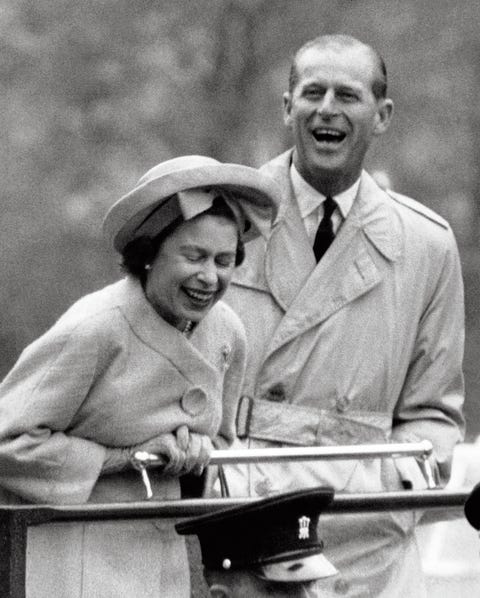
MAY 11, 1963 The Queen and Prince Philip share a moment of laughter. Their mutual sense of humor throughout the years has often been cited as one of the secrets to their successful marriage.

JUNE 25, 1960 Prince Philip visits a school in Eastbourne where students are taking part in The Duke of Edinburgh’s Award activities. Those running the organization have hailed his patronage as crucial. However, in his typical modest style, he told the BBC in 2011, “I’ve got no reason to be proud of it. It’s satisfying that we’ve set up a formula that works—that’s it.”
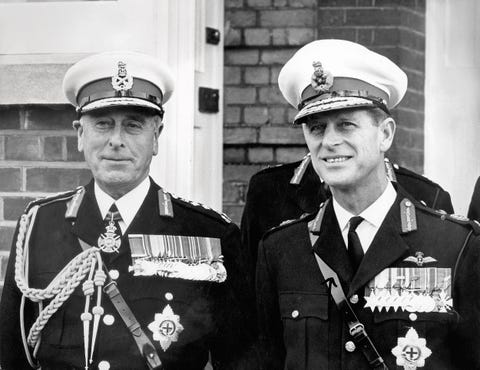
OCTOBER 27, 1965 Prince Philip stands in uniform with his uncle Louis, 1st Earl Mountbatten of Burma (left), a significant influence on his life. Philip lived with the Mountbattens for several years before his marriage to Princess Elizabeth. Mountbatten is credited with helping matchmake the relationship and was an important confidant and mentor to the young Prince Charles. In August 1979, Mountbatten and his grandson Nicholas Knatchbull, 14, were killed along with crew member Paul Maxwell, 15, when their fishing boat was blown up on the coast of Mullaghmore, County Sligo, Ireland, by the Irish Republican Army. Another passenger, the dowager Lady Brabourne, died the next day.PICTURE ALLIANCE
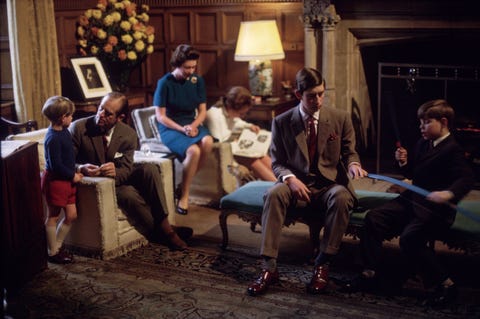
1969 The Queen and Prince Philip at Windsor Castle with their four children. The Queen is often described as having had two families, as there is a 10-year gap between her second child, Princess Anne, and her third, Prince Andrew. By the time Andrew and her fourth child, Prince Edward, were born, Elizabeth was more settled in her role as sovereign, and many observers have cited how she was able to enjoy spending more time with them.
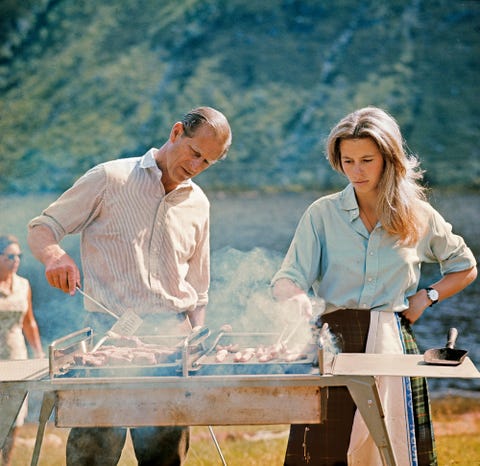
AUGUST 22, 1972 Prince Philip barbecues as daughter Princess Anne assists during the royal family’s summer holiday at Balmoral Castle, in the Scottish Highlands. Philip did not hold the traditional role of breadwinner but threw his efforts into running the family estates. In a 2008 ITV documentary, he said, “When the Queen succeeded, we sort of chatted about who would do what, I suppose. I thought that if I could relieve her of the management of the estates, it would save a lot of time.” He has also been a force for the modernization of the monarchy and was the first royal to give a television interview, in 1961.LICHFIELD

APRIL 18, 1982 The Queen and Prince Philip share a rare public display of affection as she boards a plane from Ottawa, Ontario, for London. The couple was visiting Canada for the Proclamation of the Constitution Act.BETTMANNGETTY IMAGESADVERTISEMENT – CONTINUE READING BELOW

APRIL 12, 2006 Prince Philip and grandsons Prince William and Prince Harry during Harry’s passing out parade following the completion of his training at the Royal Military Academy Sandhurst. Philip’s grandchildren speak highly of him and have gone on to champion causes, such as the environment and sport, that Philip himself started supporting decades ago. William has described him as a legend, and Harry observed about his grandparents in a 2012 BBC documentary, “Regardless of whether my grandfather seems to be doing his own thing, sort of wandering off like a fish down the river, the fact that he’s there—personally, I don’t think that she could do it without him, especially when they’re both at this age.”TIM GRAHAMGETTY IMAGES

AUGUST 2, 2017 Prince Philip waves farewell to his official duties. His final engagement was on the forecourt of Buckingham Palace. He gave his last salute to the Royal Marines outside the palace at age 96, after having been their captain more than 64 years. When it was announced Philip would be retiring, someone said to him, “I’m sorry to hear you’re standing down.” Philip replied, “Well, I can’t stand up much longer.” Since retiring, he has been seen only occasionally in public, at events such as family weddings.AFP CONTRIBUTORGETTY IMAGESADVERTISEMENT – CONTINUE READING BELOWhttps://ed9808fe950a1376276b5dc4d2d8b006.safeframe.googlesyndication.com/safeframe/1-0-38/html/container.htmlhttps://ed9808fe950a1376276b5dc4d2d8b006.safeframe.googlesyndication.com/safeframe/1-0-38/html/container.html

MAY 1 9, 2018 Prince Philip (third from left) and the Queen attend the wedding of Prince Harry to Meghan Markle. Philip’s appearance was notable because just six weeks earlier, he underwent a hip replacement operation. It was one of several hospital stays for Philip throughout his 90s. In December 2011, he had a stent fitted for a blocked coronary artery. The following June, he missed part of the Queen’s Diamond Jubilee celebrations after being taken to the hospital with a bladder infection. And in 2013, he underwent what the palace described as an “exploratory operation” on his abdomen. Philip was also hospitalized for four nights in December 2019 and discharged on December 24 to join his family for Christmas.WPA POOLGETTY IMAGES
Source: townandcountrymag.com



















